
Eremophila flaccida is a flowering plant in the figwort family, Scrophulariaceae and is endemic to Western Australia. It is a low, spreading shrub with sticky, shiny foliage and large, attractive flowers. There are two subspecies, one common and relatively widespread, the other known from only a few locations.

Boronia crenulata, commonly known as aniseed boronia, is a plant in the citrus family Rutaceae and is endemic to the south-west of Western Australia. It is an open-branched shrub, often trailing between other plants, has strap-like leaves and pink to purple-red, four-petalled flowers in winter and autumn.

Cyanothamnus baeckeaceus is a plant in the citrus family, Rutaceae and is endemic to eastern Australia. It is a slender or straggling shrub with simple or trifoliate leaves and pink and white four-petalled flowers. It is endemic to the south-west of Western Australia.

Boronia clavata, commonly known as Bremer boronia, is a plant in the citrus family, Rutaceae and is endemic to the south-west of Western Australia. It is a shrub with bipinnate leaves and pale, yellowish green, four-petalled flowers.
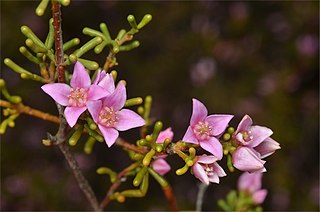
Boronia inornata, commonly known as desert boronia, is a plant in the citrus family, Rutaceae and is endemic to southern Australia. It is an erect shrub with three-part leaves and pink, red or white, four-petalled flowers.

Cyanothamnus coerulescens, commonly known as blue boronia, is a plant in the citrus family, Rutaceae and is endemic to southern Australia. It is a small, spindly shrub with glandular stems, small, more or less cylindrical leaves and blue to pinkish mauve, four-petalled flowers. There are two subspecies endemic to Western Australia and a third that also occurs in three eastern states.

Boronia juncea is a plant in the citrus family, Rutaceae and is endemic to the far south-west of Western Australia. It is an erect shrub with linear, short-lived leaves and groups of up to eight white to pink, four-petalled flowers.

Boronia octandra is a plant in the citrus family, Rutaceae and is endemic to the south-west of Western Australia. It is a small shrub with three-part leaves and greenish cream to reddish brown, four-petalled flowers.
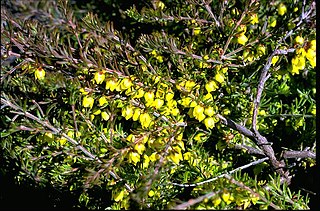
Boronia purdieana is a plant in the citrus family, Rutaceae and is endemic to the south-west of Western Australia. It is a shrub with pinnate leaves and yellow, four-petalled flowers arranged singly in leaf axils.

Boronia capitata, commonly known as the cluster boronia, is a plant in the citrus family, Rutaceae and is endemic to the south-west of Western Australia. It is a slender, spreading shrub with simple leaves and pink, four-petalled flowers.
Boronia exilis is a plant in the citrus family, Rutaceae and is endemic to a small area in the south-west of Western Australia. It is a slender, erect perennial with well-spaced, simple, more or less cylindrical leaves and pink, four-petalled flowers in groups of between three and nine on the ends of the branches.
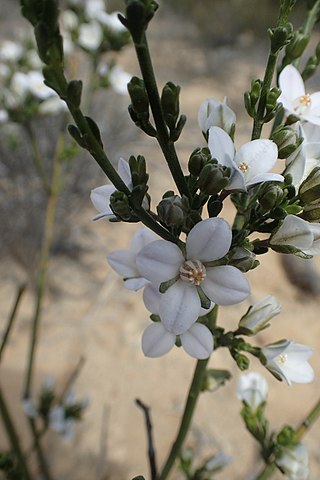
Cyanothamnus fabianoides is a plant in the citrus family, Rutaceae and is endemic to the south-west of Western Australia. It is a compact shrub with many branches, simple, more or less cylindrical leaves and single white, pink or pale blue four-petalled flowers in the leaf axils.

Boronia humifusa is a plant in the citrus family, Rutaceae and is endemic to the south-west of Western Australia. It is a low-growing, mostly hairless, wiry perennial with four-angled branches, simple, flat leaves and pink or red, four-petalled flowers in groups on the ends of the branches.
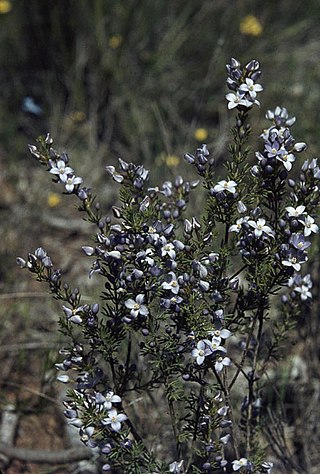
Cyanothamnus ramosus is a species of plant in the citrus family Rutaceae and is endemic to the southwest of Western Australia. It is an erect, mostly glabrous shrub with pinnate leaves with up to seven leaflets, and white, four-petalled flowers with blue or pale green backs.

Boronia revoluta, commonly known as Ironcap boronia, is a plant in the citrus family, Rutaceae and is endemic to the south-west of Western Australia. It is an erect shrub with three-part leaves and pink or white, four-petalled flowers.
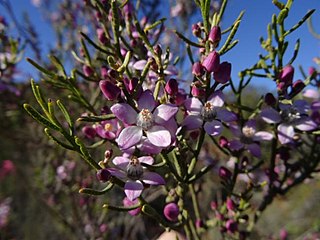
Philotheca brucei is a species of flowering plant in the family Rutaceae and is endemic to Western Australia. It is a shrub with cylindrical leaves grooved along the top and in spring, white to pink or mauve flowers with five egg-shaped petals.

Rhadinothamnus rudis is a small shrub with needle-shaped, angular branchlets and single white flowers at the end of branches. This species and the three subspecies are endemic to Western Australia.

Philotheca deserti is a species of flowering plant in the family Rutaceae and is endemic to inland Western Australia. It is an erect shrub with narrow spindle-shaped, glandular-warty leaves and white flowers arranged singly in leaf axils.

Philotheca gardneri is a species of flowering plant in the family Rutaceae and is endemic to the south-west of Western Australia. It is a shrub with crowded, narrow club-shaped or more or less spherical leaves and white flowers with a prominent pink midrib, usually borne singly on the ends of branchlets.

Philotheca nodiflora is a species of flowering plant in the family Rutaceae and is endemic to Western Australia. It is a weak shrub with more or less cylindrical leaves and blue to pink flowers arranged in compact heads.




















